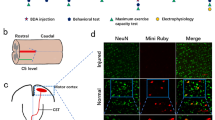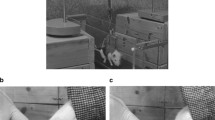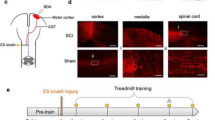Abstract
Several studies have shown that treadmill training improves neurological outcomes and promotes plasticity in lumbar spinal cord of spinal animals. The morphological and biochemical mechanisms underlying these phenomena remain unclear. The purpose of this study was to provide evidence of activity-dependent plasticity in spinal cord segment (L5) below a complete spinal cord transection (SCT) at T8–9 in rats in which the lower spinal cord segments have been fully separated from supraspinal control and that subsequently underwent treadmill step training. Five days after SCT, spinal animals started a step-training program on a treadmill with partial body weight support and manual step help. Hindlimb movements were evaluated over time and scored on the basis of the open-field BBB scale and were significantly improved at post-injury weeks 8 and 10 in trained spinal animals. Treadmill training also showed normalization of withdrawal reflex in trained spinal animals, which was significantly different from the untrained animals at post-injury weeks 8 and 10. Additionally, compared to controls, spinal rats had alpha motoneuronal soma size atrophy and reduced synaptophysin protein expression and Na+, K+-ATPase activity in lumbar spinal cord. Step-trained rats had motoneuronal soma size, synaptophysin expression and Na+, K+-ATPase activity similar to control animals. These findings suggest that treadmill step training can promote activity-dependent neural plasticity in lumbar spinal cord, which may lead to neurological improvements without supraspinal descending control after complete spinal cord injury.




Similar content being viewed by others
References
Wernig A, Nanassy A, Müller S (1998) Maintenance of locomotor abilities following Laufband (treadmill) therapy in para- and tetraplegic persons: follow-up studies. Spinal Cord 36:744–749
Behrman AL, Harkema SJ (2000) Locomotor training after human spinal cord injury: a series of case studies. Phys Ther 80:688–700
Hicks AL, Adams MM, Martin Ginis K et al (2005) Long-term body-weight-supported treadmill training and subsequent follow-up in persons with chronic SCI: effects on functional walking ability and measures of subjective well-being. Spinal Cord 43:291–298
Nooijen CFJ, ter Hoeve N, Field-Fote EC (2009) Gait quality is improved by locomotor training in individuals with SCI regardless of training approach. J Neuroeng Rehabil 6:1–11
Anneken V, Hanssen-Doose A, Hirschfeld S et al (2010) Influence of physical exercise on quality of life in individuals with spinal cord injury. Spinal Cord 48:393–399
Bouyer LJ (2005) Animal models for studying potential training strategies in persons with spinal cord injury. J Neurol Phys 29:117–125
Yates C, Charlesworth A, Allen SR et al (2008) The onset of hyperreflexia in the rat following complete spinal cord transection. Spinal Cord 46:798–803
Multon S, Franzen R, Poirrier A et al (2003) The effect of treadmill training on motor recovery after a partial spinal cord compression-injury in the adult rat. J Neurotrauma 20:669–706
Hutchinson KJ, Gómez-Pinilla F, Crowe MJ et al (2004) Three exercise paradigms differentially improve sensory recovery after spinal cord contusion in rats. Brain 127:1403–1414
Nothias J-M, Mitsui T, Shumsky JS et al (2005) Combinated effects of neurotrophin secreting transplants, exercise, and serotonergic drug challenge improve function in spinal rats. Neurorehabil Neural Repair 19:296–312
Engesser-Cesar C, Ichiyama RM, Nefas AL et al (2007) Wheel running following spinal cord injury improves locomotor recovery and stimulates serotonergic fiber growth. Eur J Neurosci 25:1931–1939
Heng C, de Leon RD (2009) Treadmill training enhances the recovery of normal step** patterns in spinal cord contused rats. Exp Neurol 216:139–147
Barbeau H, Rossignol S (1987) Recovery of locomotion after chronic spinalization in the adult cat. Brain Res 412:84–95
de Leon RD, Hodgson JA, Roy RR et al (1998) Locomotor capacity attributable to step training versus spontaneous recovery after spinalization in adult cats. J Neurophysiol 79:1329–1340
Moshonkina TR, Gilerovich EG, Fedorova EA et al (2004) Morphofunctional basis for recovery of locomotor movements in rats with completely crossed spinal cord. Bull Exp Biol Med 138:198–201
de Leon RD, Acosta CN (2006) Effect of robotic-assisted treadmill training and chronic quipazine treatment on hindlimb step** in spinally transected rats. J Neurotrauma 23:1147–1163
Zhang Y, Ji SR, Wu CY et al (2007) Observation of locomotor functional recovery in adult complete spinal rats with BWSTT using semiquantitative and qualitative methods. Spinal Cord 45:496–501
Petruska JC, Ichiyama RM, **drich DL et al (2007) Changes in motoneuron properties and synaptic inputs related to step training after spinal cord transection in rats. J Neurosci 27:4460–4471
Khristy W, Ali NJ, Bravo AB et al (2009) Changes in GABAA receptor subunit gamma 2 in extensor and flexor motoneurons and astrocytes after spinal cord transaction and motor training. Brain Res 1273:9–17
Laird AS, Carrive P, Waite PME (2009) Effect of treadmill training on autonomic dysreflexia in spinal cord-injured rats. Neuroreabil Neural Repair 23:910–920
Beaumont E, Houlé JD, Peterson CA et al (2004) Passive exercise and fetal spinal cordtransplant both help to restore motoneuronal properties after spinal cord transection in rats. Muscle Nerve 29:234–242
Bigbee AJ, Crown ED, Ferguson AR et al (2007) Two chronic motor training paradigms differentially influence acute instrumental learning in spinally transected rats. Behav Brain Res 180:95–101
Basso DM, Beattie MS, Bresnahan JC (1995) A sensitive and reliable locomotor rating scale for open field testing in rats. J Neurotrauma 12:1–21
Gale K, Kerasidis H, Wrathall JR (1985) Spinal cord contusion in the rat: behavioral analysis of functional neurologic impairment. Exp Neurol 88:123–134
Roy RR, Matsumoto A, Zhong H et al (2007) Rat α- and γ-motoneuron soma size and succinate dehydrogenase activity are independent of neuromuscular activity level. Muscle Nerve 36:234–241
Gundersen HJG, Jensen EB (1987) The efficiency of systematic sampling in stereology and its prediction. J Microsc 147:229–263
Hermel EE, Ilha J, Xavier LL et al (2006) Influence of sex and estrous cycle, but not laterality, on the neuronal somatic volume of the posterodorsal medial amygdala of rats. Neurosci Lett 405:153–158
Wyse ATS, Streck EL, Worm P et al (2000) Preconditioning prevents the inhibition of Na+, K+-ATPase activity after brain ischemia. Neurochem Res 25:969–973
Chan KM, Delfer D, Junger KD (1986) A direct colorimetric assay for Ca2+-stimulated ATPase activity. Anal Biochem 157:375–380
Peterson GL (1977) A simplification of the protein assay method of Lowry et al. which is more generally applicable. Anal Biochem 83:346–356
Bradford MM (1976) A rapid and sensitive method for the quantification of micrograms quantities of protein utilizing the principle of protein-die-binding. Anal Biochem 72:248–254
Skinner RD, Houle JD, Reese NB et al (1996) Effects of exercise and fetal spinal cord implants on the H-reflex in chronically spinalized adult rats. Brain Res 729:127–131
Reese NB, Skinner RD, Mitchell D et al (2006) Restoration of frequency-dependent depression of the H-reflex by passive exercise in spinal rats. Spinal Cord 44:28–34
Yates CC, Charlesworth A, Reese NB et al (2008) The effects of passive exercise therapy initiated prior to after the development of hyperreflexia following spinal transection. Exp Neurol 213:405–409
Ichiyama RM, Courtine G, Gerasimenko YP et al (2008) Step training reinforces specific spinal locomotor circuitry in adult spinal rats. J Neurosci 28:7370–7375
Edgerton VR, Courtine G, Gerasimenko YP et al (2008) Training locomotor networks. Brain Res 57:241–254
Edgerton VR, Roy RR (2009) Activity-dependent plasticity of spinal locomotion: implications for sensory processing. Exerc Sport Sci Rev 37:171–178
Turkin VV, O’Neill D, Jung R et al (2010) Characteristics and organization of discharge properties in rat hindlimb motoneurons. J Neurophysiol 104:1549–1565
Nakano H, Masuda K, Sasaki S et al (1997) Oxidative enzyme activity and soma size in motoneurons innervating the rat slow-twitch and fast-twitch muscles after chronic activity. Brain Res Bull 43:149–154
Zwaagstra B, Kernell D (1981) Size of soma and stem dendrites in intracellularly labeled α-motoneurones of the cat. Brain Res 204:295–309
Kitzman P (2005) Alteration in axial motoneuronal morphology in the spinal cord injured spastic rat. Exp Neurol 192:100–108
Gazula V-R, Roberts M, Luzzio C et al (2004) Effects of limb exercise after spinal cord injury on motor neuron dendrite structure. J Comp Neurol 476:130–145
de Leon RD, Tamaki H, Hodgson JA et al (1999) Hindlimb locomotor and postural training modulates glycinergic inhibition in the spinal cord of the adult spinal cat. J Neurophysiol 82:359–369
Gulino R, Dimartino M, Casabona A et al (2007) Synaptic plasticity modulates the spontaneous recovery of locomotion after spinal cord hemisection. Neurosci Res 57:148–156
Ying Z, Roy RR, Edgerton VR et al (2005) Exercise restores levels of neurotrophins and synaptic plasticity following spinal cord injury. Exp Neurol 193:411–419
Macias M, Nowicka D, Czupryn A et al (2009) Exercise-induced motor improvement after complete spinal cord transection and its relation to expression of brain-derived neurotrophic factor and presynaptic markers. BMC Neurosci 10:144
Stroemer RP, Kent TA, Hulsebosch CE (1995) Neocortical neural sprouting, synaptogenesis, and behavioral recovery after neocortical infarction in rats. Stroke 26:2135–2144
Kleim JA, Lussnig E, Schwarz ER et al (1996) Synaptogenesis and Fos expression in the motor cortex of the adult rat after motor skill learning. J Neurosci 16:4529–4535
Ding Y, Li J, Clark J et al (2003) Synaptic plasticity in thalamic nuclei enhanced by motor skill training in rat with transient middle cerebral artery occlusion. Neurol Res 25:189–194
Edelmann L, Hanson PI, Chapman ER et al (1995) Synaptobrevin binding to synaptophysin: a potential mechanism for controlling the exocytotic fusion machine. EMBO J 14:224–231
Valtorta F, Pennuto M, Bonanomi D et al (2004) Synaptophysin: leading actor or walk-on role in synaptic vesicle exocytosis? Bioessays 26:445–453
Daly C, Ziff EB (2002) Ca21-dependent formation of a dynamin-synaptophysin complex: potential role in synaptic vesicle endocytosis. J Biol Chem 277:9010–9015
Marques KB, Santos LM, Oliveira AL (2006) Spinal motoneuron synaptic plasticity during the course of an animal model of multiple sclerosis. Eur J Neurosci 24:3053–3062
Courtine G, Song B, Roy RR et al (2008) Recovery of supraspinal control of step** via indirect propriospinal relay connections after spinal cord injury. Nat Med 14:69–74
Tillakaratne NJ, Guu JJ, de Leon RD et al (2010) Functional recovery of step** in rats after a complete neonatal spinal cord transection is not due to regrowth across the lesion site. Neuroscience 166:23–33
Phillis JW (1992) Na+/K(+)-ATPase as an effector of synaptic transmission. Neurochem Int 20:19–22
Vaillend C, Mason SE, Cuttle MF et al (2002) Mechanisms of neuronal hyperexcitability caused by partial inhibition of Na+-K+-ATPases in the rat CA1 hippocampal region. J Neurophysiol 88:2963–2978
Boulenguez P, Liabeuf S, Bos R et al (2010) Down-regulation of the potassium-chloride cotransporter KCC2 contributes to spasticity after spinal cord injury. Nat Med 16:302–307
Gonzalez S, Grillo C, Gonzalez Deniselle MC et al (1996) Dexamethasone up-regulates mRNA for Na, K-ATPase in some spinal cord neurons after cord transection. Neuroreport 7:1041–1044
Labombarda F, Gonzalez SL, Gonzalez Deniselle MC et al (2002) Cellular basis for progesterone neuroprotection in the injured spinal cord. J Neurotrauma 19:343–355
van den Burg MM, Eizema K, de Graaf-Roelfsema E et al (2009) Effects of acute exercise and long-term exercise on total Na+, K+-ATPase content and Na+, K+-ATPase isoform expression profile in equine muscle. Am J Vet Res 70:895–901
Acknowledgments
The authors are grateful to the under graduate students, Carlos C. Abdala and Kamila Kazanowski for their kind assistance with the animal care over the survival period and to Antonio G. Severino for his technical assistance. This work was supported by grants from Brazilian funding agencies: CNPq (Proc. 476880/2007-6 and 470347/2007-4), CAPES and FINEP/Rede IBN 01.06.0842-00.
Author information
Authors and Affiliations
Corresponding author
Rights and permissions
About this article
Cite this article
Ilha, J., Centenaro, L.A., Broetto Cunha, N. et al. The Beneficial Effects of Treadmill Step Training on Activity-Dependent Synaptic and Cellular Plasticity Markers After Complete Spinal Cord Injury. Neurochem Res 36, 1046–1055 (2011). https://doi.org/10.1007/s11064-011-0446-x
Accepted:
Published:
Issue Date:
DOI: https://doi.org/10.1007/s11064-011-0446-x




